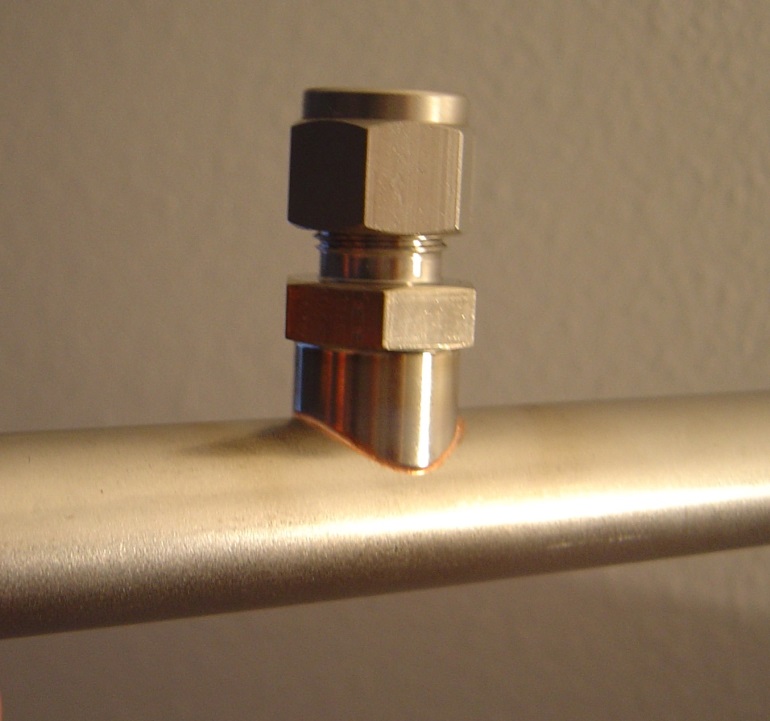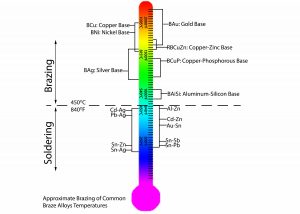The Steps for Brazing Success
April 21st, 2021

What are the steps to ensure a good braze joint?
A good, sound braze joint doesn’t happen by accident. It is the result of following good procedures long before the actual brazing process occurs. Induction brazing equipment cannot compensate for poor design or processes.
So what are the steps for producing a reliable braze joint?
- Good joint design, with proper clearances
- Clean parts, free contaminants
- Flux/Atmosphere
- Proper Braze Alloy Selection
- Suitable Fixtures
- Heating the parts
- Post-Braze Cleaning
Good Design
Brazing relies on capillary action. Capillary action is the ability of a molten braze alloy to flow into narrow gaps without the assistance of, or even in opposition to, external forces like gravity.
In order for a molten braze alloy to flow into the joint interface (faying surfaces), the parts need to have good fit-up and gap clearances. A common rule of thumb is a gap clearance of 0.001” to 0.005” when the flux is used and brazing in open air. (This is based on brazing similar metals or base materials having a similar coefficient of thermal expansion.) This allows capillary action to work, allowing the braze alloy to flow. Gaps greater than this, capillary action is reduced and the braze alloy may not fill the gap completely. A eutectic braze alloy or a near eutectic braze alloy will flow quickly and the gaps between the parts are typically smaller. An example of this is the copper brazing of fuel lines and fuel rails in a controlled atmosphere. Working with a reputable braze alloy supplier can help determine the recommended gap clearances based on the braze alloy, brazing atmosphere, and materials being joined.
What about dissimilar metals? As metal is heating, they tend to expand and dissimilar materials expand at different rates. The suggested 0.001”-0.005” gap is the gap at brazing temperature, not room temperature. For example, brass expands more than steel while being heated so take thermal expansion into account when designing parts.
Cleanliness
The materials to be joined by brazing need the faying surfaces to be clean. The materials need to be clean of grease, oils, dirt, surface oxide (including rust) for the braze alloy to adhere to the surface. The use of commercially available degreasing solutions should remove these contaminants from your pieces. Flux will not remove oil and grease and braze alloy will not adhere to oily surfaces. Surface oxides can be removed either chemically or mechanically.
Proper Flux and Atmosphere
After parts are cleaned and prior to heating, flux is applied to the parts. Flux is used to clean the residual oxides and protect base metals and filler metals from oxidizing during heating. As metals are heated, they have a greater tendency to react with oxygen in the air and it happens rapidly as parts get hotter. Flux is good, but the more is better statement doesn’t necessarily extend to brazing. Use too much flux and the flux can get entrapped into joint and potentially could be a source of voids within a brazed assembly.
In instances where brazing is performed in a controlled atmosphere such as nitrogen or argon, the amount of flux needed is reduced and often eliminated. A protective atmosphere protects the braze area from oxidation. However, in some instances, a light coating of flux is applied to reduce surface oxides.
There is not a one flux fits all situations. The choice of the flux used is dependent on the base metals being brazed or soldered and the expected brazing temperature. A solder flux cannot be used for brazing and vice versa. The most common flux used for a large number of silver brazing applications joining ferrous and nonferrous alloys is commonly referred to as a white flux or general-purpose flux (FB3A) and is effective up to a temperature of 1600°F. AWS publication A5.31, Specification for Fluxes for Brazing and Braze Welding, has more detail in the types of fluxes, useful operating ranges, and the base metals for which they are suitable. For brazing high-temperature chromium stainless steels, tungsten, and chromium carbides at temperatures up to 1800°F, an FB3A flux is typically used. When the brazing temperature is expected to be as high as 2000°F or when the parts will be at an elevated temperature in excess of 1450°F for an extended time, an FB3D flux is commonly used. Consult with a flux manufacturer to get the right flux based on the materials being joined and the expected brazing temperatures.
Proper Braze Alloy
The selection of a suitable braze alloy is critical to the success of reliable braze joints. Not every item can be brazed with the same alloy. Braze alloy manufacturers produce alloys to suit a wide variety of applications. The chemical composition of an alloy that is suitable for some base metals won’t necessarily work for other materials. For example, BCuP alloys designed for the brazing of copper cannot be used to braze steel components together while BAg silver brazing alloys with small additions of Ni and/or Mn are beneficial for the joining of carbides and brazing stainless steel as the nickel helps prevent interfacial corrosion. AWS A.5.8 specification published by the American Welding Society lists the various commercially available braze alloys and their chemical composition along with an alloy liquidus temperature and solidus temperature.
Liquidus vs. solidus and eutectic alloys.

Liquidus is the lowest temperature at which a metal is completely liquid while solidus is the highest temperature at which a metal is solid and above this temperature it begins to melt. When the liquidus temperature equals the solidus temperature, a braze alloy is considered a eutectic alloy. Commonly used eutectic alloys include pure copper, or BCu alloys, which are used as a brazing filler metal in a protective atmosphere, or BAg-8, a 72% Ag/28% Cu brazing alloy. Why is this important to know? A eutectic brazes alloy flows quickly and can fill tight gaps. Alloys with a wide gap between solidus and liquidus are sluggish and have the ability to fill wider gaps.
One of the advantages of induction brazing is the repeatability and reduction in variation with a manufacturing process. Induction equipment coupled with the correct brazing preform can make your brazing department even more efficient. A brazing preform controls the volume of brazing alloy, allows multiple joints to be brazed simultaneously, and allows for the use of automation. A brazing preform is made by fabricating braze wire or strip into various shapes – rings, washers, discs, shims – to name a few, designed by a braze alloy manufacturer for the parts to be brazed.
Proper Fixturing
The role of good fixtures is to keep the parts aligned during heating and cooling so capillary action can happen. The best fixtures are those that are low mass and poor conductors of heat to minimize the amount of heat conducted away from the braze area.
A part that can be self-fixtured, tubular joints as an example, is preferred for simplicity and versatility. Self-fixtured parts aligned with a braze preform can be easily heating with a properly designed induction heating coil. Ways this can be achieved include: allowing gravity to hold part assemblies together, staking parts, swaging, and crimping prior to brazing to name a few common methods.
If self-fixturing is not feasible, then external fixturing needs to be incorporated into the induction brazing cycle. The purpose of external fixturing is to keep parts aligned and in place during the brazing cycle. Key considerations when designing and building external fixtures include:
- Minimizing the contact with the parts to be brazed as the contact points will act as a heat sink
- The heat resistance and thermal shock resistance of the fixture materials
- Accessibility to the areas that will be heated to allow the induction heating coil to adequately heat the parts
- Care needs to be exercised to allow for thermal expansion when designing fixtures as materials expand as they are heated.
- Simplicity and ease of use and ergonomics need to be considered to minimize user fatigue and increase user adoption.
Frequently, induction brazing and soldering permit a reduction in the required number of part fixtures, with the minimal heating of the fixtures increasing fixture life span and maintaining accuracy in alignment of the components to be joined.
Heating the Parts
With the parts to be brazed fixtured and properly aligned within an induction coil, the parts are ready to be brazed. Induction heating equipment transfers energy into the heated part by means of a changing electromagnetic field. It is the varying of the electromagnetic field intensity, frequency, and time that control part heating rate and temperature. The electromagnetic field intensity is controlled by the induction coil (also known as an inductor) geometry, the power and voltage applied to the inductor, and where the part is positioned relative to the inductor.
Properly designed induction coils will heat the braze area uniformly. Molten braze alloy will flow to areas of higher temperature so care needs to be exercised to properly align the inductor with the parts to uniformly heat the parts. Radyne can assist in designing and building induction heating coils that provide the proper amount of energy to the correct areas to produce reliable and repeatable brazed parts.
Post-Braze Cleaning
The residual flux needs to be removed after brazing as most flux compositions are corrosive. If the flux residue is not removed, the brazed assembly could weaken or fail due to corrosion. Flux residuals are typically removed with a hot water rinse. In most cases, hot water and light mechanical brushing will remove the residue. Care should be exercised from aggressively bushing so that particles do not become embedded in the base metals.
Often brazed assemblies are immersed in the water soon after the braze alloy solidifies. This thermal shock cracks off the residues after brazing. If parts are quenched too soon after brazing, cracks may result and the braze joints may become rough in appearance. Quenching should not be performed with materials that have a large difference in their Coefficient of Thermal Expansion (CTE).
In circumstances with difficulty removing residue and stains, chemical cleaning may be required. Pickling solutions are a common way to remove post-braze residuals. Consult with your braze and flux alloy supplier on additional means for cleaning parts with residual flux after brazing.
Conclusion
A great, well-done braze joint is the result of following good, solid brazing procedures. By following these steps coupled with the right induction brazing equipment, repeatable, reliable, and high-quality brazing can be achieved. Induction heating is a leading candidate in manufacturing environments that embrace operational excellence and lean, six sigma.
As an induction heating industry leader, Radyne can help you navigate the challenges and realize the advantages of induction brazing. For more information on solutions for induction heating and related processes, please contact us.




